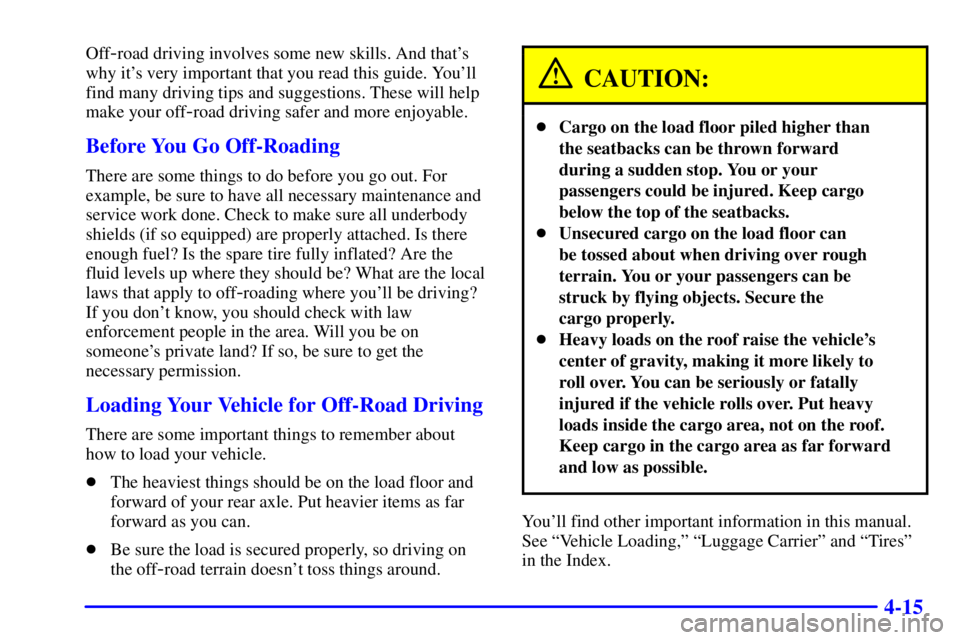Page 13 of 394
For
a More
Detailed Look at
What's Under the Hood
See Section 6
Service Station Guide
Cooling System
See Section 5
Spare Tire Pressure
See Section 6
Tire Pressure
See Section 6
Fuel
Use unleaded only.
See Section 6
for octane ratings.
Oil Viscosity
Engine Oil
See Section 6
Engine Oil Dipstick
See Section 6
Hood Release
See Section 6
Windshield Washer
Fluid
See Section 6Battery
See Section 6
Page 92 of 394
2-5
Your vehicle has one
double
-sided key for the
ignition and all door locks
as well as the spare tire
hoist lock.
Your vehicle also has a key
that locks and unlocks the
center floor console only.
If you ever lose your keys, your dealer will be able to
assist you with obtaining replacements.
In an emergency contact roadside assistance.
See ªRoadside Assistanceº in the Index for
more information.
Page 216 of 394

4-15
Off-road driving involves some new skills. And that's
why it's very important that you read this guide. You'll
find many driving tips and suggestions. These will help
make your off
-road driving safer and more enjoyable.
Before You Go Off-Roading
There are some things to do before you go out. For
example, be sure to have all necessary maintenance and
service work done. Check to make sure all underbody
shields (if so equipped) are properly attached. Is there
enough fuel? Is the spare tire fully inflated? Are the
fluid levels up where they should be? What are the local
laws that apply to off
-roading where you'll be driving?
If you don't know, you should check with law
enforcement people in the area. Will you be on
someone's private land? If so, be sure to get the
necessary permission.
Loading Your Vehicle for Off-Road Driving
There are some important things to remember about
how to load your vehicle.
�The heaviest things should be on the load floor and
forward of your rear axle. Put heavier items as far
forward as you can.
�Be sure the load is secured properly, so driving on
the off
-road terrain doesn't toss things around.
CAUTION:
�Cargo on the load floor piled higher than
the seatbacks can be thrown forward
during a sudden stop. You or your
passengers could be injured. Keep cargo
below the top of the seatbacks.
�Unsecured cargo on the load floor can
be tossed about when driving over rough
terrain. You or your passengers can be
struck by flying objects. Secure the
cargo properly.
�Heavy loads on the roof raise the vehicle's
center of gravity, making it more likely to
roll over. You can be seriously or fatally
injured if the vehicle rolls over. Put heavy
loads inside the cargo area, not on the roof.
Keep cargo in the cargo area as far forward
and low as possible.
You'll find other important information in this manual.
See ªVehicle Loading,º ªLuggage Carrierº and ªTiresº
in the Index.
Page 273 of 394
5-19 Removing the Spare Tire and Tools
Denali Models (Under Driver's Side Rear Seat)
A. Tool Kit with Jack Tools and Gloves
B. Bracket and Wing Nut
Denali Models (Rear Access Panel)
A. Speaker
B. Bottle Jack
C. Wing Nut
D. Retaining Hook
E. Tire Blocks
F. Cover Panel
Page 274 of 394

5-20
Denali XL Models
A. Bottle Jack
B. Wheel Blocks
C. Wing Nut
D. Mounting Bracket
E. Removable TrayF. Retaining Hook
G. Retaining Bracket
and Wing Nut
H. Tool Kit with Jack
Tools and GlovesDenali: The equipment you'll need is located under the
second row passenger's seat on the driver's side of the
vehicle, and behind the left trim panel on the driver's
side of the vehicle. Skip the first step and follow the
last three.
Denali XL: The equipment you'll need is located
under the storage tray in the rear trim panel on the
driver's side of the vehicle.
1. Remove the tray to access the tools.
2. There is a wing nut used to retain the tool kit.
To remove it, turn the wing nut counterclockwise.
3. To release the bottle jack from its holder, turn
the knob on the bottle jack counterclockwise
to lower the jack head.
4. The wheel blocks and the wheel block
retainer can be removed by turning the
wing nut counterclockwise.
You'll use the jack handle extensions and the wheel
wrench to remove the underbody
-mounted spare tire.
Page 275 of 394

5-21
A. Hoist Assembly
B. Wheel Wrench
C. Jack
Handle Extensions
D. Hoist Shaft
E. Valve Stem,
Pointed Up
F. Spare TireG. Tire Retainer
H. Hoist Cable
I. Hoist Lock
J. Hoist Shaft
Access Hole
K. Hoist End of
Extension ToolFollow these instructions to lower the spare tire:
1. If the vehicle is equipped with a hoist lock (I), open
the spare tire lock cover on the bumper and use the
ignition key to remove the lock.
2. Assemble the wheel wrench (B) and the two jack
handle extensions (C) as shown. Insert the hoist
end (K) (open end) of the extension through the
hole (J) in the rear bumper. Be sure the hoist end
of the extension connects into the hoist shaft (D)
(the ribbed square end of the extension is used to
lower the spare tire).
3. Turn the wheel wrench counterclockwise to lower
the spare tire (F) to the ground. Continue to turn the
wheel wrench until the spare tire can be pulled out
from under the vehicle. The wheel wrench has a
hook that allows you to pull the hoist cable (H)
towards you, to assist in reaching the spare tire.
4. When the tire has been lowered, tilt the retainer at
the end of the cable so it can be pulled up through
the wheel opening.
5. Put the spare tire near the flat tire.
Page 278 of 394
5-24 Removing the Flat Tire and Installing the
Spare Tire
1. Use the wheel wrench to loosen all the wheel nuts.
Turn the wheel wrench counterclockwise to loosen
the wheel nuts. Don't remove the wheel nuts yet.
Position the jack under the vehicle. If the flat tire is
on the front of the vehicle, position the jack on the
frame behind the flat tire.
If the flat tire is on the rear of the vehicle, use the
jacking pad provided on the rear axle.
CAUTION:
Getting under a vehicle when it is jacked up is
dangerous. If the vehicle slips off the jack, you
could be badly injured or killed. Never get under
a vehicle when it is supported only by a jack.
CAUTION:
Raising your vehicle with the jack improperly
positioned can damage the vehicle and even
make the vehicle fall. To help avoid personal
injury and vehicle damage, be sure to fit the jack
lift head into the proper location before raising
the vehicle.
Page 279 of 394
5-25
Front Position
Rear Position
2. For the front position, make sure that the jack is
positioned where the sections of frame overlap.
For the rear, make sure the jack head is positioned
so that the rear axle is resting securely between the
grooves that are on the jack head. Turn the wheel
wrench clockwise to raise the vehicle. Raise the
vehicle far enough off the ground so there is enough
room for the spare tire to fit back underneath the rear
of the vehicle.